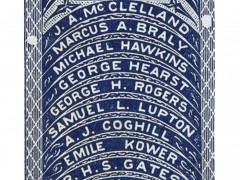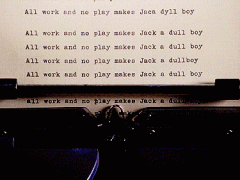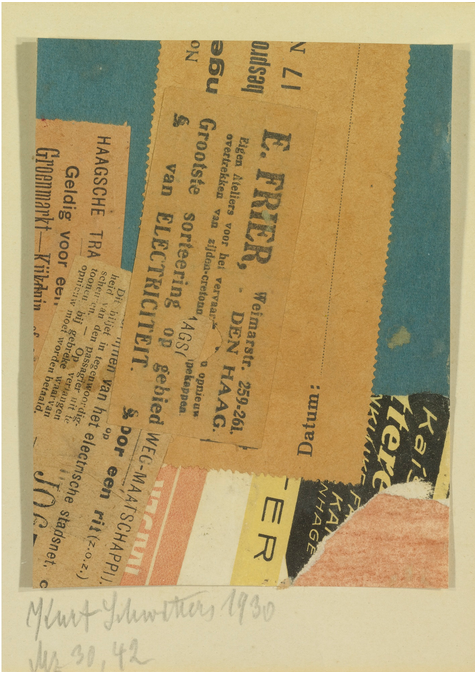Kurt Schwitters: MoMA pays tribute to the creator of Merz
In the midst of MoMA’s brand new exhibition Engineer, Agitator, Constructor: The Artist Reinvented there is a gallery dedicated to the work of Kurt Schwitters.
The German artist, performer, publisher, poet, and graphic designer Kurt Hermann Eduard Karl Julius Schwitters (20 June 1887 – 8 January 1948) who was born in Hanover, Germany, has worked in several genres and media, including dadaism, constructivism, surrealism, poetry, sound, painting, sculpture, graphic design, typography, and what came to be known as installation art.
Reaching fame with his collages, called Merz Pictures, Schwitters asked to join Berlin Dada either in late 1918 or early 1919, according to the memoirs of Raoul Hausmann. Hausmann claimed that Richard Huelsenbeck rejected the application because of Schwitters' links to Der Sturm and to Expressionism in general, which were seen by the Dadaists as hopelessly romantic and obsessed with aesthetics. Ridiculed by Huelsenbeck as 'the Caspar David Friedrich of the Dadaist Revolution', Schwitters replied with an absurdist short story Franz Mullers Drahtfrühling, Ersters Kapitel: Ursachen und Beginn der grossen glorreichen Revolution in Revon published in Der Sturm (xiii/11, 1922), which featured an innocent bystander who started a revolution 'merely by being there'. Yet Hausmann's anecdote about Schwitters asking to join Berlin Dada is, somewhat dubious, for there is well-documented evidence that Schwitters and Huelsenbeck were on amicable terms at first.
Though not a direct participant in Berlin Dada's activities, Schwitters employed Dadaist ideas in his work, used the word itself on the cover of An Anna Blume, and would later give Dada recitals throughout Europe on the subject with Theo van Doesburg, Tristan Tzara, Jean Arp and Raoul Hausmann.
In many ways, his work was more in tune with Zürich Dada's championing of performance and abstract art than Berlin Dada's agit-prop approach, and indeed examples of his work were published in the last Zürich Dada publication, Der Zeltweg, November 1919, alongside the work of Arp and Sophie Tauber. Whilst his work was far less political than key figures in Berlin Dada, such as George Grosz and John Heartfield, he would remain close friends with various members, including Hannah Höch and Raoul Hausmann, for the rest of his career.
Also the made-up word Merz, a synonym for the more common expression and term Dada, and traces back to Schwitters who planned a Dada section in Hanover. Not being invited to the First International Dada Fair in Berlin in 1920, Schwitters was on the look-out for a "totally unique hat fitting only a single head." His own.
Schwitters found Merz by chance when creating a collage with the German word Kommerz (commerce). The result: a nonsensical‚ dadaistic’ word. Merz became Schwitters 's very synonym for his own way of Dada. Merz has been called 'Psychological Collage'. Most of the works attempt to make coherent aesthetic sense of the world around Schwitters, using fragments of found objects.
Whilst these works were usually collages incorporating found objects, such as bus tickets, old wire and fragments of newsprint, Merz also included artists' periodicals, sculptures, sound poems and what would later be called "installations". Schwitters was to use the term Merz for the rest of the decade.
Schwitters published a periodical, also called Merz, between 1923 and 1932, in which each issue was devoted to a central theme. Merz 5 1923, for instance, was a portfolio of prints by Jean Arp, Merz 8/9, 1924, was edited and typeset by El Lissitsky, Merz 14/15, 1925, was a typographical children's story entitled The Scarecrow by Schwitters, Kätte Steinitz and Theo van Doesburg. The last edition, Merz 24, 1932, was a complete transcription of the final draft of the Ursonate, with typography by Jan Tschichold.
His work in this period became increasingly Modernist in spirit, with far less overtly political context and a cleaner style, in keeping with contemporary work by Jean Arp and Piet Mondrian. His friendship around this time with El Lissitzky proved particularly influential, and Merz pictures in this period show the direct influence of Constructivism.
Kurt Schwitters, a pioneer in fusing collage and abstraction, influenced Robert Rauschenberg, Jasper Johns, the Fluxus movement and Joseph Beuy.
Among the more than 300 works on view, Schwitters’s poster for Opel Day: Great car and flower parade poster is one of the few black-and-white objects that captured the attention of graphic designers, Kevin Ballon and David Klein.
“Some might find it sterile, but to us the contrast between the austere palette and playful design elements only entices us to decode its logic. The layout appears systematic and logical at first, but the more you look at it the more you discover quirks: How did Schwitters determine the width of those generous indents? Why are some Os bolder than others? And why is there text set vertically on the bottom left? The playfully typeset Opeltag on the bottom right is like a visual onomatopoeia; you can almost feel the words form in your mouth as you read it” they write.
As noted an audio guide in which curator, designer, and educator Ellen Lupton elaborates on Schwitters’s typography is available here.
“In this poster for a car show, Schwitters was experimenting with creating a new alphabet. It really annoyed him that the letters of the alphabet are so arbitrary. He wanted to reform the writing system so that the shapes of the alphabet would have more of a connection to the sounds of speech. So, if you look closely at the letterforms in this poster, you’ll see that all the vowels are drawn with curves and the consonants are drawn with straight lines” Lupton explains.
“Schwitters’s impulse to question convention and improve the way we communicate touches on some of the most powerful qualities of design. In every act of making something, the designer has a choice: to uphold established norms or to challenge them. While his design for this poster did challenge the conventions of language, production constraints ultimately forced Schwitters to halt this particular project. In the end, what we are left with is a timeless reminder that even mundane projects are opportunities to express our convictions—and to produce an awesome looking poster” notes the duo.
Engineer, Agitator, Constructor is on view through April 10, 2021, and is organized by Jodi Hauptman, Senior Curator, and Adrian Sudhalter, Consulting Curator, with Jane Cavalier, Curatorial Assistant, Department of Drawings and Prints, The Museum of Modern Art.
More here.
Tags/ exhibition, ellen lupton, poster, moma, berlin, germany, dada, kurt schwitters, merz





.jpg)










.png)



.png)
_.png)



